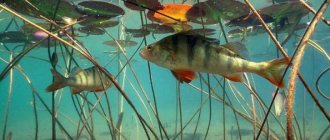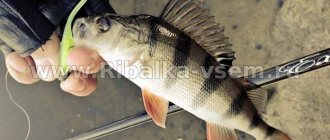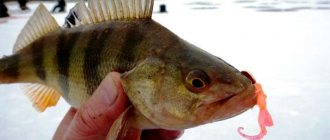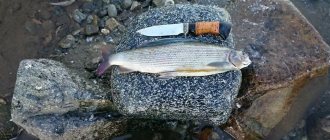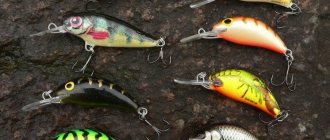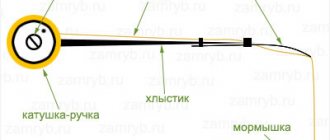Bait for fishing
Let's start with the fact that the live bait should be from 4 to 10 cm and, most importantly, it should be quite mobile. Otherwise, if the bait dies, the pike will simply lose interest in it. Pike is better caught using live bait, which is caught in the same reservoir where the pike itself is found. I recommend these live baits:
- Rotan
- Perch
- Roach
- crucian carp
- Gudgeon
You can attach live bait to the back, upper lip and gills.
Features of catching pike with live bait at different times of the year
The behavior of this predatory fish directly depends on the time of year.
Spring
In the spring, starting from March, pike actively searches for food. Therefore, many believe that it is during this period that the biggest catch is made. The predator bites best near the shore.
Summer
But in summer, on hot days, it is best to catch pike in the cool time of day, for example, in the morning or evening. Cool, cloudy days are also suitable. In hot weather, this predator is very difficult and difficult to catch. During this period, fish often live in various snags, overgrown areas of the reservoir and shaded areas.
Autumn
In the fall, fish have a great appetite, so they will bite bait of any size. In autumn there is a high chance of catching pike at any time of the day.
Winter
In winter, pike are caught using girders on which bait is installed. After you have placed the girders, it is advisable to run next to them or walk, tapping something on the ice. This is a really necessary step, since the sounds of footsteps can drive the fish out of its hiding place.
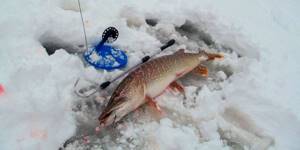
How to catch pike in the summer using a spinning rod
It must be said that hunting for predatory fish with a spinning rod, be it pike perch, pike or perch, can take place both from the shore and from the side of the boat. The determining factor is how far from the shore the active fish-biting zone (or its resting place) is located.
The predator's stranded sites can be identified by circles in the water from fattening fish. Such “traces” are often left by small predators, since large individuals are less mobile. After identifying the predator’s parking spot, it is necessary to determine what bait to offer it. In such situations, either floating wobblers or rotating lures of large numbers show themselves to be very effective. It is better not to use small baits for catching large toothed predators. There is a very high probability that a small pike will bite on them, fussing with which will alert large prey.
When setting up a spinning rod for pike fishing, you must take into account the leash. The average pike, having been hooked, begins to spin in the water, winding the fishing line around its body, after which it bites above the leash and leaves. Leashes, in turn, are classified: metal and fluorocarbon. Pike will not be able to bite on metal leashes even if they want to, but they bite an order of magnitude less than on fluorocarbon.
Large pike behave somewhat differently when fishing. She resists evenly and powerfully, making sharp jerks from time to time, in the hope of getting into the snag. You can't do this without good gear. Fishing is a task with many unknowns, and many of its components are also variables. For example: the influence of atmospheric processes on fish. Quite often, contrary to accepted canons, active biting occurs under unimaginable weather conditions, and it happens that even in ideal atmospheric conditions, a fisherman leaves the shore empty.
Casting must be done while facing the sun, without creating a shadow from the angler into the pond. With a practiced cast, the pike bites in the first ten seconds after the bait is placed in the water (it is noticed only in the summer). When you catch pike with a twister (with a soft tail), very often, when equipped with a double, the tail falls on the hook, which leads to unsuccessful retrieval. Therefore, it is necessary to monitor the twister while casting.
If you go fishing for pike, you should always be prepared for success (to catch it). In order to increase the likelihood of success, you need to have a landing net in your arsenal. For a pike fisherman, when fishing for pike, manipulations with the landing net become automatic. The landing net should lie to the angler's left, at arm's length.
Spinning
In addition to choosing a good and correct spinning rod for fishing, it is also important to know the intricacies of its use.
The spinning rod is equipped with medium-sized spinning reels. The length of the rod reaches from 1.3 to 4 meters. If you fish from the shore, it will be more convenient to use a spinning rod from 2.5 meters.

Pike caught with a spinning rod
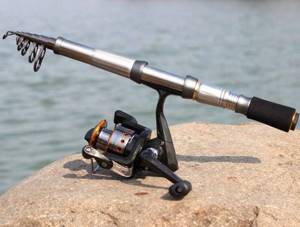
Spinning
Summer fishing gear
In the summer, pike can be caught with two types of gear: live bait and artificial bait.
Live bait is bottom tackle with a fishing line of great thickness and length, wound on a simple reel or reel. Thanks to the small sinker, the bait does not leave the hook and allows you to catch the predator using a single large hook or several doubles or treble hooks.
It all works like this: the fish eats the bait, swallowing it along with the hook, and moves towards the shelter; the moment the fish moves to the spot, the fisherman catches it.
Note! Artificial baits - spinning tackle with a 3-meter long fishing rod, a spinning reel and a supply of fishing line. Presented in the form of all kinds of circles, spinners, artificial soft fish and vibrating tails.
Float rod
One of the most accessible basic ways to catch pike. The length of the rod should be no more than 4 meters; for a larger reservoir, use a rod from 5 to 6 meters. Don't choose a float that is too light or a float that is too heavy. An egg-shaped float will do.
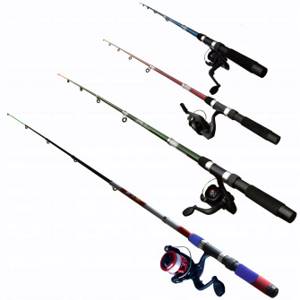
Coil
You need to take the choice of reel seriously. Do not buy dubious reels from little-known or completely unfamiliar manufacturers. Look at the reviews, or take reels known from your experience. For spinning, spinning reels are often used. Choose reel spool sizes in the region of 1500-2000.
When fishing for pike, you can also use simple drum reels on a float rod.
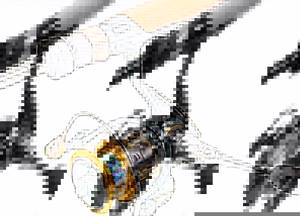
Spinning reel

Reel for float rod
Pike fishing in open water
There are several ways to catch pike during the open water season. Pike can be caught with a spinning rod, with a float rod, with live bait, with a donka, with summer baits and with mugs.
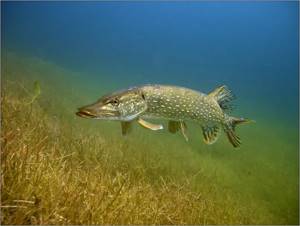
Some of these methods require the presence of a boat, others can be carried out both from a boat and from the shore. Each angler chooses for himself the method that suits him best based on the conditions in which he has to fish, the availability of certain fishing gear, and his personal preferences in fishing.
Spinning
Pike fishing with a spinning rod is the youngest, and at the same time, the most popular way of catching this predatory fish. The principle of spinning fishing is to cast the bait using a rod and then retrieve it by rotating the reel and moving the rod.
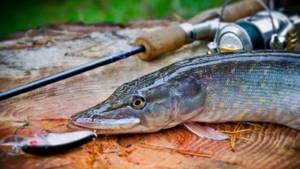
Fishing for pike with a spinning rod involves constantly moving the angler around the reservoir to search for active pike, changing baits and constantly experimenting with a variety of fishing rods. You can catch pike with a spinning rod throughout the open water season, from early spring to late autumn, with the exception of the time of spawning ban. Fishing for pike with a spinning rod can be done both from the shore and from a boat, but as a rule, a boat greatly expands the angler’s capabilities.
For pike fishing, a spinning rod is used, equipped with a spinning reel on which a cord is wound, to which an artificial bait is attached through a leash. Pike fishing with spinning rods can be done both from the shore and from a boat. To catch pike from the shore, use a rod with a length of 2.7 m, and when fishing from a boat it is easier to use a shorter rod with a length of 2.1-2.4 meters.
The diameter of the fishing line (cord) is selected taking into account the expected size of the prey. For pike fishing, both braided lines and monofilaments are used.
When fishing for pike, you must use a leash, the function of which is to protect the fishing line from the sharp teeth of the pike. The leash is most often made of Kevlar, titanium, tungsten or guitar string. Some fishermen use fluorocarbon leashes when fishing for pike; they are almost completely invisible in the water, but are less resistant to pike teeth than metal leashes.
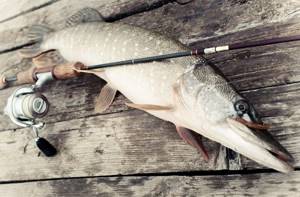
A wide variety of spinning lures are used for pike fishing:
Oscillating spinners -
one of the oldest spinning baits. They are a metal plate curved in the longitudinal or transverse direction, in the tail part of which a tee is fixed. When moving in the water, the oscillating spoon moves from side to side, rolls from side to side or trembles slightly, creating vibrations of a certain amplitude and frequency that attract predatory fish. Oscillating spoons are used for catching pike both in still water and in the current. Oscillating spoons are quite versatile, easy to use and inexpensive, which is why they are very popular among anglers.
Spinners
easy to use and catchy, most beginning spinners begin their journey in spinning by fishing with spinners. Spinner baits consist of a wire rod on which is attached a metal petal and a treble hook. When the spoon moves in the water, during the retrieve, the petal rotates around the rod, creating high-frequency vibrations and glare in the water that attract predators. Rotating spoons have numbers that indicate the size of the blade of the spoon, spoons come in sizes from 00 to 6. For catching small and medium-sized pike, rotating spoons numbered 2 and 3 are well suited; for catching large pikes, spinners numbered 4 to 6 are used.
Silicone baits
are a very popular class of lures for pike fishing. Silicone baits come in a wide variety of shapes and types, the most common among them: twisters, vibrotails, worms, octopuses, crustaceans, frogs. Many types of silicone baits resemble in their appearance real food items of predatory fish, others are completely fantasy. Silicone baits are divided into edible and inedible; attractants are added to edible baits, which additionally attract fish with their smell and taste. Silicone baits are available in a large number of different colors. For fishing, silicone baits are mounted on a jig head or on an offset hook connected to an eared sinker (Cheburashka). Lately, fishing with spaced-out rigs has become increasingly popular among spinning anglers: retractable leash, drop-shot, Carolina and Texas rigs. The method of fishing with silicone baits is called jig.
You may be interested in: Sudak
Wobblers
are solid baits, their appearance resembling fry and intended for catching predatory fish. Wobblers can be of different sizes. To catch large pike, you can use wobblers with a length of 100 mm and above. For catching medium-sized pike, wobblers 7-10 cm long are suitable. Wobblers vary in shape, each of which has its own name: minnow, shad, crank, fat and others. Good results when fishing for pike are shown by minnow wobblers, which are carried out with a special jerking retrieve called twitching. Other types of wobblers show good results: shads, poppers, cranks. Wobblers vary in the degree of buoyancy; they are: floating, suspended and sinking. Wobblers also vary in depth, they can be: surface, subsurface, shallow, deep, ultra-deep. Depending on the fishing conditions, the angler selects a wobbler that is suitable in terms of its parameters and characteristics.
Live bait fishing rod
Many anglers catch pike on a float rod with live bait attached to a hook. To catch pike with a fishing rod, anglers use a long telescopic rod, which allows them to cast into windows of clear water. An inertial or spinning reel is installed on the fishing rod; most anglers use a spinning reel, which is much easier to use.
A leash must be installed between the fishing line and the hook, which can be metal, Kevlar, titanium, tungsten, guitar string or fluorocarbon fishing line. Fluorocarbon leashes are less noticeable in the water, but less resistant to pike teeth than metal leashes.
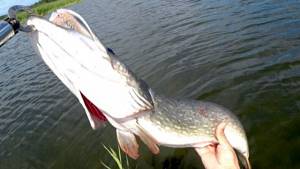
The float must be special for fishing with live bait; it is barrel-shaped and has a large carrying capacity so that the live bait cannot drown it. The float must be loaded up to the antenna. You can buy a float at a fishing store or make it yourself from a champagne cork. The float should be visible at a distance of up to 20 meters. The hooks used are relatively small; they can be triple, double or single.
When choosing live bait, you should take into account the degree of its survivability; pike prefers live and active fish; it most often ignores dead ones. Good bait for live bait: small crucian carp, carp, gudgeon, roach. It is best to catch live bait in the same body of water where fishing will take place; pike are more willing to catch food that is familiar to it. If there are a lot of frogs in the body of water where you are fishing for pike, they are most likely a frequent prey for pike, so fishing for a frog will most likely be successful. Live bait must be released into the water.
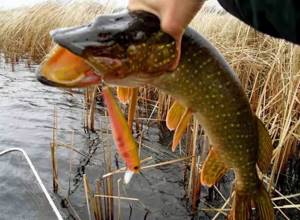
Fishing for pike with a live bait rod is most effective in the summer on small rivers with gentle currents and heavily overgrown reservoirs with standing water. It is better to catch pike with a live bait rod from a boat in order to increase the number of places fished.
After casting live bait, the fisherman waits five to seven minutes; if during this time there is no bite, he should move to another place. The fisherman can periodically return and re-fish old fishing spots that have already been fished.
Bottom fishing rod
A bottom fishing rod is not the best tackle for catching pike. In summer, pike stay in thickets of underwater vegetation, in snags. In such places there is no opportunity to perform a normal cast and to land the caught pike on the bottom tackle.
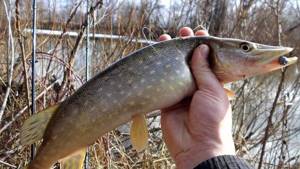
Many anglers successfully catch pike using bottom tackle in water bodies that are clear of underwater vegetation and snags. At the same time, they use both a classic donk and a donk with a rubber shock absorber. The best time for such fishing is spring, when the underwater vegetation has not yet had time to grow, and late autumn, when the bulk of the underwater vegetation has already died off. You can cast bottom gear along the shallows where pike come out to feed. You can use live bait or a frog as bait. Pike of all sizes are caught with live bait, and, as a rule, the largest individuals are caught with frogs.
If you choose between a classic donka and bottom tackle with a rubber shock absorber, then you should give preference to rubber, which does not require the use of a boat for repeated casts and creates much less noise that scares away pikes.
Catching pike with summer baits
The supply rig is the oldest equipment for catching pikes. The zherlitsa has an extremely simple device. You can fish with a zherlitsa on a pond, lake or small river. Grills are installed in places where pike often hunt for small fish: in windows among aquatic vegetation, under trees overhanging the water, next to flooded bushes.
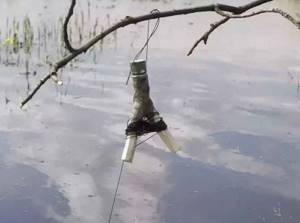
The zherlitsa consists of:
- A reel, which can be made from a wooden flyer with splits at the ends, from a plank, plywood or even a plastic bottle.
- Fishing line of sufficient strength, wound on a reel, at least 7 meters long
- A lead sinker, which is needed to hold live bait so that it does not go into the grass
- Fluorocarbon leader tied to the fishing line via a swivel
- Hook, quite large in size, which can be triple, double or single
Live bait is attached to the hook of the girder and the tackle is thrown into the water. The best live bait for catching pike in summer: bleak, dace, perch, roach, gudgeon. The fishing line is inserted into the split of the flyer in such a way that when the pike takes the bait, the fishing line is released from the split, and later, when the fishing line finishes unwinding, the pike will hook itself. The reel is tied to a tree and a pole driven on the shore or in the water.
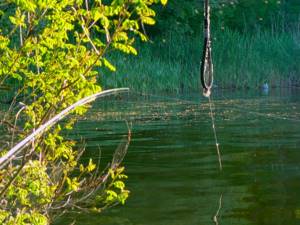
Anglers who fish with girders install several girders in the most promising places in the reservoir, and, as a rule, leave them overnight. In the morning, fishermen go around the girders one by one and check them.
Fishing with mugs
A circle is a floating version of a summer vent. The circle is a foam float in the form of a disk, which has a groove for winding fishing line at the end. Different sides of the disk are painted in different colors, usually white and red. When a pike grabs a live bait, the circle turns over with its bright side up, alerting the angler to a bite.
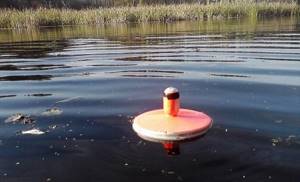
There are two ways to catch pike with mugs. The first method is used on calm rivers and lakes; mugs with attached hooks are allowed to float freely. The mugs slowly float through the water, under the influence of the current and the force of the wind, and look for the pike themselves. The second method of fishing with circles is to secure the circles in one place using a fishing line with a sinker attached to it. In this case, the mugs are placed near snags, next to thickets of grass, that is, in those places where actively feeding pike often hang out.
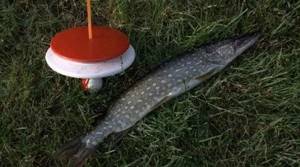
Pike fishing with mugs is done from a boat. In order to catch the maximum area of the reservoir, the mugs are installed or floated in a checkerboard pattern. The mugs must be within the angler’s visibility at all times so that he can react to pike bites.
It is best to use live bait taken from the same reservoir where pike fishing will be carried out for baiting mugs. Live bait is placed at half-water or forty centimeters from the bottom. During the fishing process, the fishing horizon is changed, depending on which horizon the bites most often occur on.
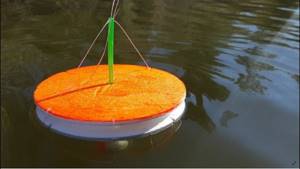
The fisherman must constantly monitor the circles and as soon as one of them is triggered, he slowly and carefully, trying not to scare off the pike that took it, swims up to the triggered circle. The fisherman carefully collects the line into the boat, and as soon as he feels the heaviness, he makes a hook and begins to fish out the caught pike. Pike are caught in circles throughout the open water season, but the best time for this method of pike fishing is September-October, the time of the autumn pike feeding season.
You might be interested in: Croatian egg
fishing line
The reliability of landing your caught fish depends on the fishing line. Choose the thickness of the fishing line based on the weight of the bait.
- Monofilament line (nylon thread)
The advantage of this line is that it is quite strong, does not tangle, and, thanks to its transparency, is invisible in the water. This type of fishing line is most often used for fishing with a float rod. But the line also stretches well. This prevents the caught prey from being pulled out.
- Braided cord
Has higher strength. It stretches much worse, so it is easier to pull out the prey. Has various flavors to attract fish. Unfortunately, it gradually begins to absorb water, which prevents the use of wicker in winter at low temperatures.
- Fluorocarbon line
It is often used when fishing with spinning rods. Invisible in water, durable, wears out with difficulty, however, the price is higher than that of other fishing lines.
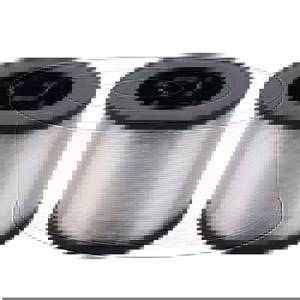
Monofilament line

Braided cord
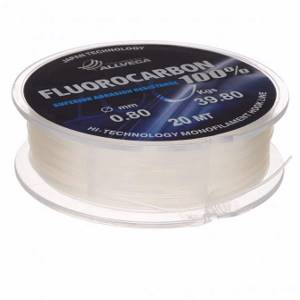
Fluorocarbon line
Pike habitats in summer
Pike lives in almost all deep rivers. There she hides under snags, on sand spits, because there is plenty of food there, which helps her survive and reproduce all year round.
Snags are a place with submerged trees that have fallen into the water and slow down the water flow, forming an eddy with changes in depth. Sawdust accumulates in them, which provides additional cover for predatory fish and a place to live.
Thickets of grass are the second most popular place where fish like to spend the winter and live in the first half of summer. The fish actively hide and hunt here.
She also actively lives and hunts in the mornings and evenings on sand spits. The duration of the bite in such a place is no more than an hour, but due to the concentration of a large number of small fish, there are a lot of predators observed here. You can catch more than 10 pieces at a time.
Bridge areas are another favorite spot for pike. This is where small fish like to be, which they feed on.
Good to know! Backwaters with tributaries, all kinds of man-made canals, locks and dams are places where pike actively gather. They burrow in holes and hunt other fish.
Leash
- The fluorocarbon leash is transparent, but it is less durable than other leashes, so it is suitable for catching small specimens.
- Kevlar is quite soft and durable, the price is low.
- Titanium is a more durable leash, suitable for catching large pike, but the price is higher than previous materials.
- Steel - you can make such a leash yourself, for example, from old strings. The pike will not be able to chew through a steel leash, which is a plus.
Which leash is better, decide for yourself, based on the desired size of the caught predator.

Kevlar leash
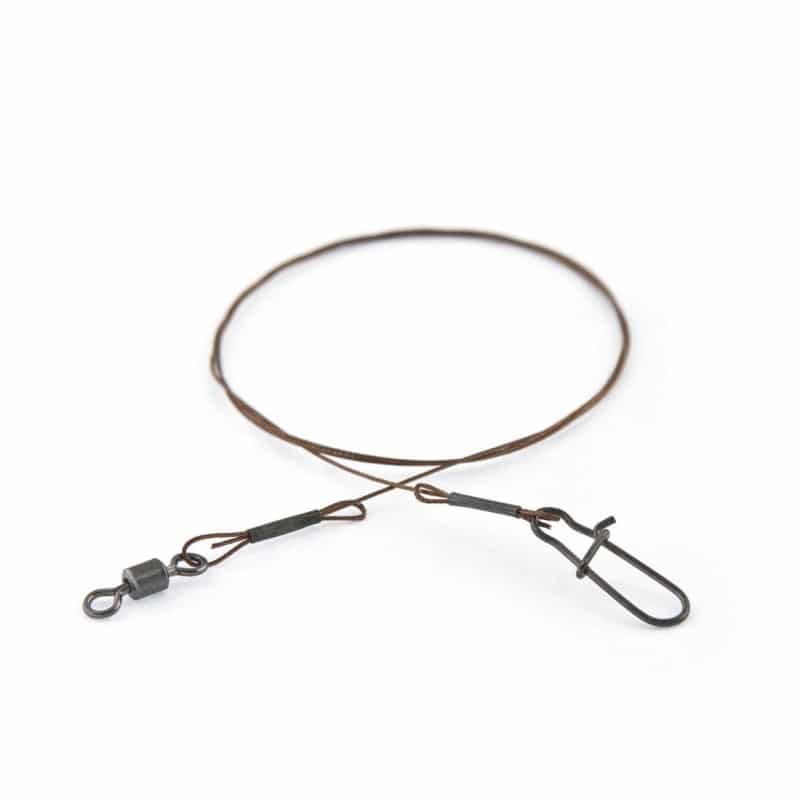
Steel leash
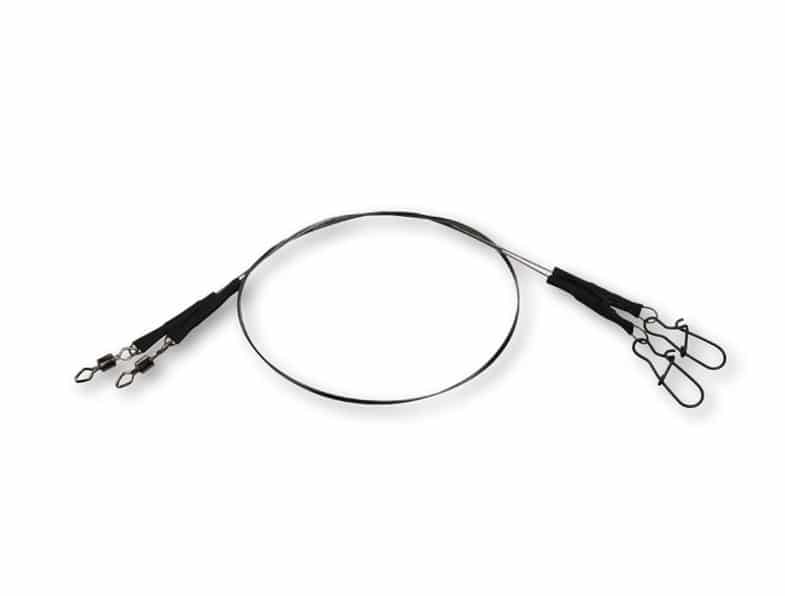
Titanium leash
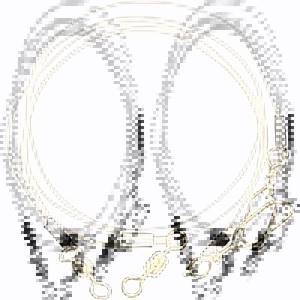
Fluorocarbon leader
How to catch pike on a donk
![How to catch pike with live bait [vgodu]](https://korabel29.ru/wp-content/uploads/kak-pojmat-shchuku-na-zhivca-vgodu.jpg)
Bottom tackle is quite popular among fishermen even now. It is quite easy to assemble. A fishing line is wound onto the spool, and the bait is attached to a hook, which is located on the leash.
The sinker is attached above the hook, but in some versions it is installed vice versa below.
The fishing rod is placed on a special stand on the shore.
A simpler option is a cast , consisting of a strong thick fishing line with a leash, hooks, a reel at the beginning and a weight at the end.
![How to catch pike with live bait [vgodu]](https://korabel29.ru/wp-content/uploads/kak-pojmat-shchuku-na-zhivca-vgodu2.jpg)
Techniques for catching pike with live bait
Spinning
- Carefully cast the bait bait on the hook. There is no need to try to cast over a long distance; up to 15-20 meters will be enough.
- Beginners are advised to slowly reel in the fishing line with pauses, simultaneously tugging the end of the spinning rod.
- Hooking is carried out after each bite. It's important to let your prey get tired.
- Now the main thing. Fishing. As soon as you feel the predator moving underwater, pull the line. Then slowly lift the rod, and then lower it down with a sharp jerk. Next, the fishing line is reeled in very quickly. If the fish resists, raise and lower the spinning rod several times until the pike gets tired and it becomes possible to bring it into the landing net.
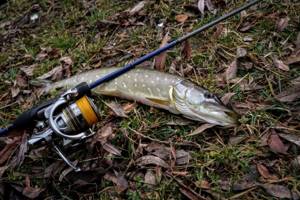
Choosing effective baits for summer pike fishing
When selecting bait, it should be taken into account that pike is a voracious predator; with the exception of pre-spawning time, it prefers large baits. Therefore, there is no need to shallow, especially considering that fishing is planned in the summer. Use wobblers and spinners 10-15 cm long. This will eliminate the likelihood of bites from even large perch, and will also reduce the number of bites from small pike.
Oscillating lures and cranks work best for pike in the summer; of course, you should take into account the peculiarities of the place; if the area is heavily overgrown with grass, then it is more profitable to use non-hooking baits or even silicone baits with an offset hook. The color shade matters, but note that in the case of pike it is not special. But still, you should not use bright colors on sunny days and dull colors on cloudy days. The choice must be made the other way around.
You can successfully catch a predator using buzzbaits and spinnerbaits. The advantages of these baits are that they allow wiring in all layers, they easily bypass obstacles, which eliminates the possibility of forming a blind hook. Especially often, such variants of artificial bait are used when fishing an unknown body of water.
Jig fishing using silicone lures is used less frequently when fishing for pike, but these types of baits are still beginning to help out in areas where the bottom is heavily overgrown with grass. Note that the retrieve using such baits is carried out evenly, the bait should be at a distance of at least 20-30 cm from the bottom. Dragging it along the bottom, as when catching pike perch, gives weak results, the predator rarely decides to attack, it likes it better when the bait moves slowly through the thickness in open space.
In conclusion, we would like to add that while fishing you don’t need to stay in one place for a long time. 3-4 casts are made to areas different from the promising place; if a bite does not occur, we move away 20 meters. It is important to remember that the angler who often changes the place of fishing and does not forget to experiment with baits in relation to them has a greater chance of catching pike. size, type, color design.


